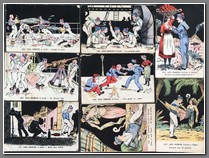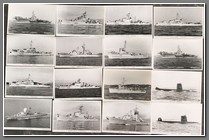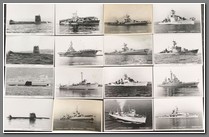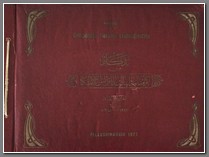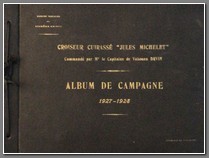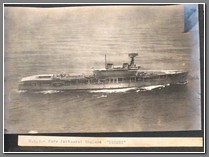Navy and Pirates
1927 tribute album from the Compagnia Italiana Transatlantica for the 1927 pilgrimage to Mecca. At the time, the fleet consisted of 21 steamers and picked up passengers from North Africa and the east coast of Africa bound for Mecca. The album is written in Italian and Arabic.
Price: $800.00
Note from Wikipedia: Transatlantica Italiana S.A. di Navigazione was acquired by Hamburg America Line when they purchased Ligure Brasiliana in 1913, but was registered under the Italian flag. In 1914 the name was changed to Transatlantica Italiana (CITRA) and in 1915, following the entry of Italy into the Great War, an Italian board of directors was formed and all German held shares were purchased. In 1932 the Citra merged with the Tirrenia - Flotte Riunite Florio – Citra.
Official album of the cruiser “Jules Michelet”, commanded by Captain d Vaisseau Devon. It covers the campaign of 1927-1928 in Indochina. 132 very well captioned photos covering all stops of the campaign, including Wang – P’ou, Shanghai, Zi-Ka-Wei, Chi-Wan-Tao, Port Arthur, Seoul, Nagasaki, Yokahama, Kyoto, Miajama, Amoi, Hong Kong, Halong, Saigon, Cam Ranh, Hue, and Manilla. SOLD
Price: $900.00
Note from Wikipedia: Jules Michelet was laid down in June 1904 as a modified version of the Leon Gambetta class class of armoured cruisers. It was slightly longer and heavier than the previous class, and while it had a similar machinery layout, with 28 boilers supplying vertical triple-expansion steam engines which drove three propeller shafts, the engines delivered 1,500 ihp (1,100 kW) more power, allowing the ship to reach a design speed of 22.5 knots (41.7 km/h; 25.9 mph). The ship was fitted with four funnels. During the First World War, Jules Michelet was part of the Mediterranean Fleet, spending the whole of the war in the Mediterranean.[6] At the start of the conflict, Jules Michelet and the armored cruisers Ernest Renan and Edgar Quinet were mobilized as the First Light Division and tasked with hunting down the German battlecruiser SMS Goeben and the light cruiser Breslau. The French ships, along with a flotilla of twelve destroyers, were to steam to Philippeville on 4 August, but the German cruisers had bombarded the port the previous day. This attack, coupled with reports that suggested the Germans would try to break out of the Mediterranean into the Atlantic, prompted the French high command to send Jules Michelet and the First Light Division further west, to Algiers to block the Germans. After the German ships escaped to Constantinople, rather than attack the French troop transports from North Africa as had been expected, the French turned to address the next naval threat: the Austro-Hungarian Navy in the Adriatic Sea. Edgar Quinet joined the rest of the French fleet in its blockade of the Adriatic, based out of Navarino. The fleet, commanded by Admiral Augustin Boué de Lapeyrère, had assembled by the night of 15 August; the following morning, it conducted a sweep into the Adriatic and encountered the Austro-Hungarian cruiser SMS Zenta. In the ensuing Battle of Antivari, Zenta was sunk, with no losses on the French side. The French fleet then withdrew due to the threat of Austro-Hungarian U-boats in the area. Twelve of Jules Michelet's 47 mm guns were removed during the war, replaced by four anti-aircraft guns of similar size. She took place in the evacuation of the Serbian army from Corfu to Bizerta in 1915 and later supported Allied operations in the Salonika campaign. Following the signing of the Armistice of Mudros, ending the participation of Turkey in the First World War, Jules Michelet was deployed through the Dardanelles into the Black Sea in November 1918.
Jules Michelet went on a brief tour of French Indochina in 1922–1923 with the armoured cruiser Victor Hugo. The pair left France on 12 October 1922, arriving on 19 April 1923. They cruised East Asian waters until 10 May when they departed for France, which they reached on 11 July. Jules Michelet was deployed to Indochina for a lengthier stay as the flagship of the Far East squadron in the late 1920s; she left France on 15 June 1925 and arrived in July. She remained there until May 1929, when she was replaced by Waldeck-Rousseau. Jules Michelet returned to France on 10 July 1929, after which she was paid off and placed in reserve. She was disarmed the following year and was used as a barracks ship at Toulon. The ship was later used as a target ship for aircraft and submarines, being sunk by the submarine Thétis in 1937.
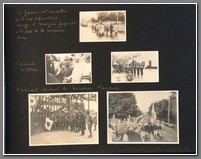 NAV 085Photo album belonging to a sailor who spent much of his time aboard the colonial sloop “Amiral-Charner”. The album begins with the bombardment of Wuhan on February 18, 1938. It shows a wounded Chinese soldier, French marines, the Chinese attempting to shelter in the French Concession as the Japanese approach, Chinese sampans attempting to block the river, Japanese torpedo boats preceeding the arrival of the convoy, the Japanese Northern Army advancing through the streets, Father Jaquinot welcoming the Japanese at the gates of the French Concession, the Italian Consul conversing with a Japanese officer, diplomatic negotiations between the French and Japanese military, Chinese attempting to escape by sampan, visiting the destruction at Hankow, visit of Father Jacquinot in his attempt to establish a safety zone, Chinese slaughter pigs in the French Concession, Japanese soldiers during Occupation of Wuhan, French military being addressed on July 14, 1938, a reception given in honor of the Japanese army at the French Club. As “Amiral-Charner” passes down river it passes naval wreckage at Matang, en route to Indochina. Reaching Saigon there is a brief trip to the interior before moving on to Bangkok. In Cambodia they visit Angkor and Prah Khan. At Cap St Jacques one of the officers gets married, construction of a telegraph tower, returning with the “Primauguet”, passing Table Mountain and Diego Suarez, aboard the “Annomite” from December 1939 to February 1940, in camp at Carbone, France, November 11, 1940. Visiting a Navy youth camp in Narbonne from April, 1941-July 1942. Stationed at Narbonne, coping with flooding, waiting for next assignment. In August 1942, he embarks for Dakar aboard the “Georges Leygues”. On November 8 he embarks for North Africa. He witnesses the scuttling of the Vichy French fleet at Toulon on November 26. From January to June 1943 he is on active patrol duty in the Atlantic and in September 1945 he is at a Naval School. 216 well and legibly captioned photos. SOLD
NAV 085Photo album belonging to a sailor who spent much of his time aboard the colonial sloop “Amiral-Charner”. The album begins with the bombardment of Wuhan on February 18, 1938. It shows a wounded Chinese soldier, French marines, the Chinese attempting to shelter in the French Concession as the Japanese approach, Chinese sampans attempting to block the river, Japanese torpedo boats preceeding the arrival of the convoy, the Japanese Northern Army advancing through the streets, Father Jaquinot welcoming the Japanese at the gates of the French Concession, the Italian Consul conversing with a Japanese officer, diplomatic negotiations between the French and Japanese military, Chinese attempting to escape by sampan, visiting the destruction at Hankow, visit of Father Jacquinot in his attempt to establish a safety zone, Chinese slaughter pigs in the French Concession, Japanese soldiers during Occupation of Wuhan, French military being addressed on July 14, 1938, a reception given in honor of the Japanese army at the French Club. As “Amiral-Charner” passes down river it passes naval wreckage at Matang, en route to Indochina. Reaching Saigon there is a brief trip to the interior before moving on to Bangkok. In Cambodia they visit Angkor and Prah Khan. At Cap St Jacques one of the officers gets married, construction of a telegraph tower, returning with the “Primauguet”, passing Table Mountain and Diego Suarez, aboard the “Annomite” from December 1939 to February 1940, in camp at Carbone, France, November 11, 1940. Visiting a Navy youth camp in Narbonne from April, 1941-July 1942. Stationed at Narbonne, coping with flooding, waiting for next assignment. In August 1942, he embarks for Dakar aboard the “Georges Leygues”. On November 8 he embarks for North Africa. He witnesses the scuttling of the Vichy French fleet at Toulon on November 26. From January to June 1943 he is on active patrol duty in the Atlantic and in September 1945 he is at a Naval School. 216 well and legibly captioned photos. SOLD
Price: $3500.00
Note: The Amiral-Charner was a Bouganville class colonial sloop built for the French navy by Ch Maritime du Sud Ost (Bordeaux, France) and launched October 1, 1932. It was scuttled on March 10, 1945 at My-Tho, Indo-China on 10 March 1945. It was one of 5 Bouganville class ships lost during the war.
Ten "De Bougainville" class ships will be built between 1931 and 1940. Eight of them will return to service before the Armistice of June 1940. The last two will not be completed in time. These vessels, designated "warships for distant (colonial) campaigns, or Avisos" were capable of a large range, and their shallow draft should allow them to go up the rivers of Asia and Africa. The Avisos were the first French surface ships to be fitted with diesel engines.
The construction of the Aviso "Admiral Charner" was entrusted to the Forges et Chantiers de la Gironde in 1931. The new ship launched in October 1932, entered service in April 1934. As soon as it was put into service, it sailed to Saigon and then Noumea. Integrated into the Far East Fleet, it participated in the evacuation of the French citizens at Nanking during the fighting there in 1937. The Japanese were raping over 5,000 female a day and hundreds of thousands of unarmed Chinese civilians and soldiers were massacred.
At the outbreak of World War II, the ship was still based in the Far East. After the Armistice, on January 16 and 17, 1941, "Admiral Charner" took part in the battle of Koh Chang between the French and Thai fleets. The latter suffered a severe defeat. Until 1943, the ship carried out escort missions of convoys in the Indian Ocean. In 1944, it sailed up the Mekong River to Pnom Penh, which allowed it to avoid Japanese air attacks. However, on March 9, 1945, the Japanese Armies launched a coup to seize French Indochina. The Japanese Forces had already been present on the territory since 1940, but the administration and management of the Indochinese territory had been left to the French. The Japanese thus take total control of the French colony. To avoid capture, the crew of the Aviso "Admiral Charner" scuttled the ship on March 10, 1945 in the port of Mytho.
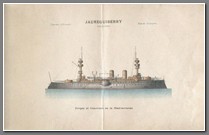 NAV 084Forges & Chantiers de la Mediterranee 1900. 32 pages of named ships of the Russian, Greek, French, Japanese and Brazillian navies. French Shipwrights record book of designs and builds detailing steam Cruisers, torpedo boats etc for the French Nany, Russian, Navy, etc dating from circa 1900. Not found in Wikipedia. SOLD
NAV 084Forges & Chantiers de la Mediterranee 1900. 32 pages of named ships of the Russian, Greek, French, Japanese and Brazillian navies. French Shipwrights record book of designs and builds detailing steam Cruisers, torpedo boats etc for the French Nany, Russian, Navy, etc dating from circa 1900. Not found in Wikipedia. SOLD
Price: $1200.00
Note from Wikipedia: The Forges et Chantiers de la Méditerranée company was founded in 1853 by Louis Henri Armand Béhic (1809-1891) supported by Napoleon III. Originally, it consisted of a shipbuilding yard in La Seyne and a forge mechanics workshop in Marseille, under the technical direction of François Bourdon. In 1856, it took the name Société Nouvelle des Forges et Chantiers de la Méditerranée. In a few years, after installing various armoring , sheet metal and boilermaking workshops, it fulfilled orders for warships for export (Russia, Italy, Brazil, etc.).
In 1872, it acquired establishments in Le Havre 4 including the shipbuilding yard in Graville-Sainte-Honorine and the Mazeline engine and propeller factory. They were sold to Schneider et Cie in 1897. At the beginning of the 20th century rearmament program and even built assault tanks during and after the First World War, including the FCM 2C. The bombing of production sites during the Second World War interrupted its production. After the war, an effort to modernize the sites was undertaken. The shipbuilding crisis in France, starting in 1959, put the sector in decline. Major construction sites are closed. The Forges et Chantiers de la Méditerranée ceased operations from July 1, 1966. The company was taken over by the CNIM ( Constructions navales et Industrielles de la Méditerranée ).




